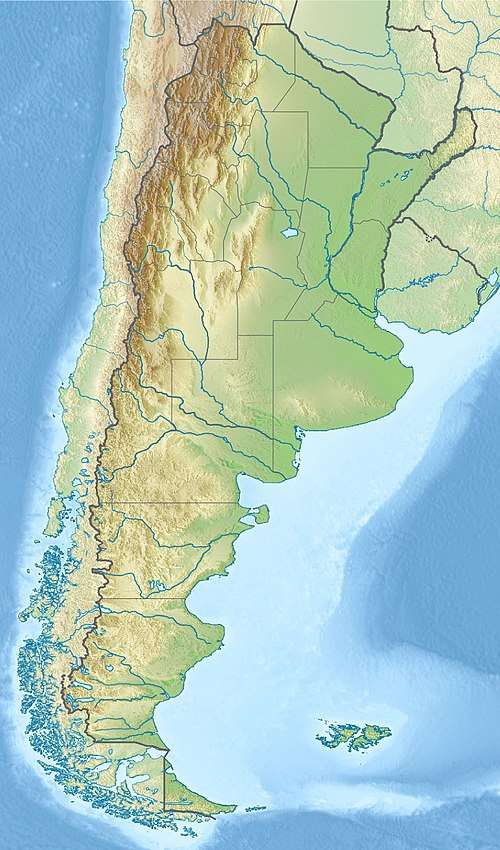La Amarga Formation
The La Amarga Formation is a geologic formation with outcrops in the Argentine provinces of Río Negro, Neuquén, and Mendoza. It is the oldest Cretaceous terrestrial formation in the Neuquén Basin.
| La Amarga Formation Stratigraphic range: Barremian-Early Aptian ~130–120 Ma | |
|---|---|
| Type | Geological formation |
| Unit of | Rayoso Group |
| Sub-units | Puesto Antigual, Bañados de Caichigüe & Piedra Parada Members |
| Underlies | Lohan Cura Formation |
| Overlies | Agrio Formation |
| Thickness | 160 m (520 ft) |
| Lithology | |
| Primary | Sandstone |
| Other | Mudstone |
| Location | |
| Coordinates | 39.6°S 70.2°W |
| Approximate paleocoordinates | 39.6°S 35.2°W |
| Region | Río Negro, Mendoza & Neuquén Provinces |
| Country | |
| Extent | Neuquén Basin |
| Type section | |
| Named for | La Amarga Arroyo |
| Named by | Musacchio |
| Year defined | 1970 |
 La Amarga Formation (Argentina) | |
The type locality is La Amarga Arroyo and China Muerta Hill.[1] The La Amarga Formation unconformably overlies the marine Agrio Formation of the Mendoza Group. It is in turn overlain by the Lohan Cura Formation, separated by another unconformity.
Composition
There are three members within the La Amarga Formation.
- The oldest is the Puesto Antigual Member, which is approximately 28.9 metres (95 ft) thick and consists mainly of sandstone deposited in the channels of a braided river system. Paleosols, or soil deposits, are well-developed.
- The Bañados de Caichigüe Member is the next highest, approximately 20.9 metres (69 ft) thick. Alternating limestones, shales, and siltstones make up this member, indicating a lacustrine (lake) environment.
- Youngest and thickest is the Piedra Parada Member, approximately 109.4 metres (359 ft) thick in some sections. This member consists of alternating sandstones and siltstones from an ancient alluvial plain, with some swamp and paleosol deposits.
Fossil content
Most of the tetrapod fossils found in the La Amarga come from the Puesto Antigual Member, including:
- a crocodilian (Amargasuchus)
- a dicraeosaurid sauropod (Amargasaurus)[2]
- a diplodocoid sauropod (Zapalasaurus)
- a titanosaurian sauropod
- an abelisauroid theropod (Ligabueino)
- a stegosaur (Amargastegos)
- a mammal (Vincelestes)
Dinosaurs
Color key
|
Notes Uncertain or tentative taxa are in small text; |
| Dinosaurs of the La Amarga Formation | |||||
|---|---|---|---|---|---|
| Genus | Species | Province | Member | Notes | Images |
|
A. cazaui[2] |
Neuquén[2] |
Puesto Antigual |
"Braincase and associated postcranial skeleton."[3] |
| |
|
Amargastegos |
A. brevicollus |
Neuquén |
Puesto Antigual |
Considered dubious by Galton & Carpenter (2016), material referred to Stegosauria indet.[4] | |
|
A. macni |
Neuquén |
Puesto Antigual |
"Two caudal vertebrae, an incomplete right ischium, a right femur, an incomplete right tibia, an incomplete right fibula, a right astragalus, and an incomplete right metatarsal I." | ||
|
L. andesi[2] |
Neuquén[2] |
Puesto Antigual |
"A cervical neural arch, a mid to posterior dorsal neural arch, a posterior dorsal centrum, the left femur, left ilium, articulated pubic shafts, and two pedal phalanges."[5] | ||
|
Stegosauria indet.[6] |
Indeterminate |
Neuquén |
Puesto Antigual |
"Supraorbital, cervical and caudal vertebrae, dermal armor".[4][6] | |
|
Z. bonapartei |
Neuquén |
Piedra Parada |
|||
Other tetrapods
| Other tetrapods of the La Amarga Formation | |||||
|---|---|---|---|---|---|
| Genus | Species | Province | Member | Notes | Images |
|
A. minor |
Neuquén |
Puesto Antigual |
A trematochampsid crocodylomorph, found in association with the holotype of Amargasaurus. |
| |
|
Pterosauria indet.[7] |
Indeterminate |
Neuquén |
An isolated femur. | ||
|
V. neuquenianus |
Neuquén |
Puesto Antigual |
A cladotherian mammal. | ||
See also
- List of dinosaur-bearing rock formations
References
- Musacchio, 1970
- Weishampel, David B; et al. (2004). "Dinosaur distribution (Early Cretaceous, South America)." In: Weishampel, David B.; Dodson, Peter; and Osmólska, Halszka (eds.): The Dinosauria, 2nd, Berkeley: University of California Press. Pp. 563-570. ISBN 0-520-24209-2.
- "Table 13.1," in Weishampel, et al. (2004). Page 264.
- Galton, Peter M. & Carpenter, Kenneth, 2016, "The plated dinosaur Stegosaurus longispinus Gilmore, 1914 (Dinosauria: Ornithischia; Upper Jurassic, western USA), type species of Alcovasaurus n. gen.", Neues Jahrbuch für Geologie und Paläontologie - Abhandlungen 279(2): 185-208
- Carrano, M.T., Loewen, M.A. and Sertic, J.J.W. (2011). "New Materials of Masiakasaurus knopfleri Sampson, Carrano, and Forster, 2001, and Implications for the Morphology of the Noasauridae (Theropoda: Ceratosauria). Smithsonian Contributions to Paleobiology, 95: 53pp.
- Pereda-Suberbiola, Xabier; Galton, Peter M.; Mallison, Heinrich; Novas, Fernando (2012). "A plated dinosaur (Ornithischia, Stegosauria) from the Early Cretaceous of Argentina, South America: an evaluation". Alcheringa: An Australasian Journal of Palaeontology. 37 (1): 1–14. doi:10.1080/03115518.2012.702531.
- Montanelli, S. B. 1987. Presencia de Pterosauria (Reptilia) en la For mation La Amarga (Hauteriviano-Barremiano), Neuquén, Argentina. Ameghiniana 24:109-113
Further reading
- Apesteguía, Sebastián. 2007. The sauropod diversity of the La Amarga Formation (Barremian), Neuquén (Argentina). Gondwana Research 12. 533–546. Accessed 2016-02-16.
- Leanza, H.A.; S. Apesteguia; F.E. Novas, and M.S. De la Fuente. 2004. Cretaceous terrestrial beds from the Neuquén Basin (Argentina) and their tetrapod assemblages. Cretaceous Research 25. 61–87. Accessed 2019-02-16.
- Musacchio, E. 1970. Ostrácodos de la superfamilias Cytheraceae y Darwinulaceae de la Formación La Amarga (Cretácico inferior), provincia del Neuquén, Argentina. Ameghiniana 7. 301–318.
